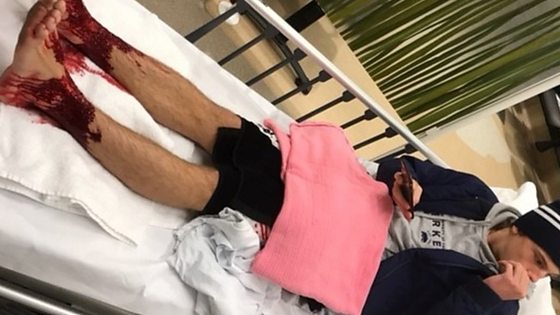
What could leave a person`s ankles and feet covered in blood as they stood, unaware of what was happening, in shallow water on a popular beach?
Images of 16-year-old Sam Kanizay`s injuries in Melbourne, Australia, have seized attention around the world.
His father, Jarrod Kanizay, said his son had arrived home with what "looked like a war injury" after soaking his legs in Melbourne`s Brighton Beach following a football game.
Experts believe the multiple pin-prick injuries were most likely tiny bite marks.
What was the likely culprit?
Mr Kanizay said doctors could not say for certain, so he returned to the bayside beach and used pieces of steak to capture "thousands of these little mite-type bugs".
"I collected these strange creatures from the same spot last night by trapping them in a net and standing in the water myself," he told the BBC.
Mr Kanizay sent samples to marine biologists at Museums Victoria, who identified them as a species of crustacean called the amphipod, or sea flea, mostly likely from the lysianassidae family.
However another expert, Dr Murray Thomson from the University of Sydney, said he believed the creature was another type of crustacean, an isopod called cirolana harfordi.
WARNING: This article contains a close up image of the injury.
What do these animals usually eat?
Amphipods feed largely on dead marine animals such as fish and crabs, and are themselves prey for larger marine animals.
"If we did not have them, we would have a sea full of dead fish and dead birds," Dr Genefor Walker-Smith, the marine biologist who viewed Mr Kanizay`s sample, told the Australian Broadcasting Corp.
Dr Thomson said isopods also eat mainly dead fish and marine worms, as well as living fish.
Both amphipods and isopods are mainly active at night.
So why did this happen?
It was most likely a combination of factors, including time of day and cold water numbing Sam`s skin, according to experts.
The teenager has described standing for about 30 minutes before feeling pins and needles around his ankles, then shaking off what he initially took to be sand.
Associate Prof Richard Reina, from Monash University, described the case as very unusual.
"It`s only when you get the potential for hundreds or thousands of them to start biting you, for a long period, that you get the type of injury that Sam had," he told the BBC.
"Unless you`re effectively numb, [usually] you`re going to notice and get out of the water before that happens."
Dr Walker-Smith said it is possible that Sam may have interrupted the animals feeding on something else.
Why did the bleeding continue?
The teenager and his family have said it took time for the blood to clot, and that on Monday it was "still seeping".
Assoc Prof Reina said this was probably due to tissue damage caused by having so many small bites.
He likened Sam`s ordeal to being bitten by mosquitoes or leeches.
"If you imagine that you had your arms exposed somewhere and you had hundreds of mosquitoes biting your arm, without you realising it for some reason, then they could probably cause some fairly significant wounds as well," he said.
Is is cause for alarm?
Not according to experts, who say small crustaceans are found in abundance - making this incident an "unfortunate coincidence".
Dr Walker-Smith said it was much more likely for someone to suffer bites on a smaller scale and have only minor irritation.


0 comments:
Post a Comment